North Wind, Meet Dirt Roads: the Rawland Nordavinden 650B
The Nordavinden is a newly released bicycle model from the small West-Coast company Rawland Cycles. Earlier this year I featured a friend's Rawland rSogn, which I could not ride because it was too big. At the time Rawland did not make a bike in my size, but they informed me that one would be coming out later in the year. We talked about a test ride, and as luck would have it, a demo bike was ready just before D2R2. I had it in my possession for a nice long weekend - most of it spent riding local and not so local dirt roads.
Norwegian for "the north wind," the Nordavinden was designed as a lighter, sportier frameset than its more rugged predecessors: a zippy bike with low trail geometry that accepts fat tires. Full geometry and tubing specs are available here. Like all Rawland models, the Nordavinden is designed in California and handbuilt in Taiwan.
The larger sizes are built for 700C and will fit a tire up to 35mm. The small size is built for 650B and will fit a tire up to 42mm (pictured here with Grand Bois Hetres).
The frame is designed for sidepull or centerpull brakes. The demo bike came fitted with Rivendell's (discontinued) Silver big-mouth sidepulls.
The dramatic curvature of the fork is immediately noticeable - prompting lots of low trail questions from those who saw the bike whilst in my possession. The trail is 30mm, with 650Bx42mm tires.
Unlike its predecessor rSogn's double plated crown, the Nordavinden's fork crown is the more minimal Pacenti Artisan II, with lighter fork blades.
The "ice blue" paint is a light, shimmery sky-blue. I tried to take some pictures that eliminated the shimmer and showed the true colour underneath. In person, the shimmer makes the blue look lighter. Compared to the (very similar) colour of the rSogn, the Nordavinden is cooler and a bit more saturated.
Looking at the Nordavinden next to the rSogn (front), they are similar at first glance, but less so upon closer inspection. The Nordavinden has an almost level top tube (1.5° slope), compared to the rSogn's more prominent slope. The Norvavinden's appearance is sleeker and more roadish - with fewer braze-ons, narrower tire clearances, lower bottom bracket, shorter chainstays.
The frame itself is welded cro-moly steel, with some decorative flourishes.
A Rawland chain-slap protector is included with the frame set,
As well as a Rawland seat collar.
The size Small is described as a 54cm frame, measured by its top tube. My ideal frame size for a road fit would have a 53cm top tube, but the small Nordavinden worked nicely with a slightly shorter stem.
The demo model was built up with Velocity Synergy rims, White Industries hubs, a SRAM Apex drivetrain,
Chris King headset, Soma threadless stem and handlebars, Tektro short reach brake levers and bar-end shifters. The build was not done for me specifically, but I did have a say in stem length and handlebar width, to ensure the bike would fit me. Were this my own bicycle, I would do some things differently for sure. But sometimes it can be interesting to use unfamiliar components.
For shifters, I had a choice between SRAM brifters and bar-ends, and opted for the latter. Prior to this I had not used bar-end shifters in over a year, and it took me a bit to free my brain from Campagnolo ergo mode. By the end, the SRAM bar-ends grew on me, though I still prefer Campagnolo ergos on my own bike.
I used my own pedals and saddle, and installed two bottle cages. The bike did not come equipped for carrying a front load, as it was optimised to do, so I used a saddlebag when I needed to carry a camera and other items. The bike - as shown here, but without bag and water bottles - weighed just over 24lb.
I rode the Rawland Nordavinden for a total of 150 miles over the course of 4 days. First was a 30 mile shake-down ride, which included 12 miles of local dirt roads. The following day, I rode a 50 mile route at the D2R2, over half of which was dirt. The day after, I did a 40 mile local ride that included a paved road, a dirt road, and a rather technical dirt trail. And after that, I did a final 30 mile ride on paved roads - including a couple of hill climbs - before returning the bike.
What I noticed about the Rawland immediately, was that my sense of balance was different on it than on other roadbikes I've ridden recently. I found tight cornering easier than it typically is for me, and I found it surprisingly easy to change my position on the bike without disturbing its balance - allowing me the freedom of activities I usually have trouble with, such as drinking from the water bottle while riding. I remember similar handling when riding the Royal H. Randonneur last summer, but this time I think I was able to appreciate it more - particularly on unpaved terrain. At the D2R2, I was able to descend on loose dirt and gravel faster than I was comfortable doing previously, and to drink all the water I wanted without having to stop. It certainly added to my enjoyment of the day. The following morning, I rode unceremoniously on a somewhat challenging local dirt trail that I've never been willing to ride before.
As far as speed, the Rawland is plenty fast and accelerates with no hesitation. There is a snappy, responsive, roadish feel to it. On pavement it is not quite as fast as my Seven roadbike, and it does not climb quite as effortlessly. But as soon as the pavement ends, the dynamic changes. It's as if the two bikes were made to be friends and supplement each other. The Rawland glides over dirt and gravel, seemingly preferring them to pavement. In part, of course, it is the wide tires - which don't bounce me around the way narrow road tires do. But it's also the handling - again, that peculiar flavour of maneuverability that comes with low trail - that makes it easy for me to pick a line through rutted out areas and to corner on loose sections without reducing speed. On a bike with standard front end handling, I feel less confident riding on winding, unpaved roads and trails - especially descending. This preference might be particular to me, I don't know. But I found the Rawland's handling exceptionally agreeable for riding on dirt.
Notably, carrying weight in the rear was not a problem despite the bike's low trail design. It did not feel much different than riding without a saddlebag, except on steep climbs (with a full saddlebag, the front end "wandered" a bit). I do not know what the bike feels like to ride with a handlebar bag, but I can only imagine that not worse, considering that it's designed for one. I should also point out that I do not know what the bike feels like to ride long distances; my longest single ride on it was only 50 miles. With its front rack braze-ons, a bike like this just begs to be taken on a long, self-supported ride, and I hope to soon read some reviews from owners who've done that.
To think of criticisms is not an easy task here. I suppose I would like the bike even better if it were lighter, though I recognise the weight is pretty good for a bike of its kind. Another thing I can say is that I am fairly spoiled at this point as far as ride quality, and from that perspective the Rawland is not the cushiest bike I've ever ridden. It isn't a harsh ride by any means, but I feel that much of the cush is due to the fat tires - and that with narrower ones I would feel the bumpy roads more. Finally, as I've mentioned already, on pavement the Rawland is not as fast as my Seven - but then I don't think it makes sense to pit them against each other; they are not meant for the same kind of riding. I would not mind owning a bike like the Rawland to supplement my skinny tire roadbike.
While showing off the demo bike, more than a couple of times I was asked why only the smallest Nordavinden size is offered in 650B. I must say I wonder as well, as it is precisely the combination of the wide 42mm Grand Bois Hetre tires and the handling that draws me to the bike. There is demand out there for lightweight, sporty low trail 650B bikes without having to spend a fortune on custom work. The Rawland Nordavinden retails at $725 for the frameset (available from Rawland Cycles directly). While I cannot vouch for the other sizes, I suspect the 650B Nordavinden is a bike that many would appreciate for road-to-trail riding.
Many thanks to Rawland Cycles for loaning out the demo bike, and thanks to the Ride Studio Cafe for putting it together.
More pictures here.



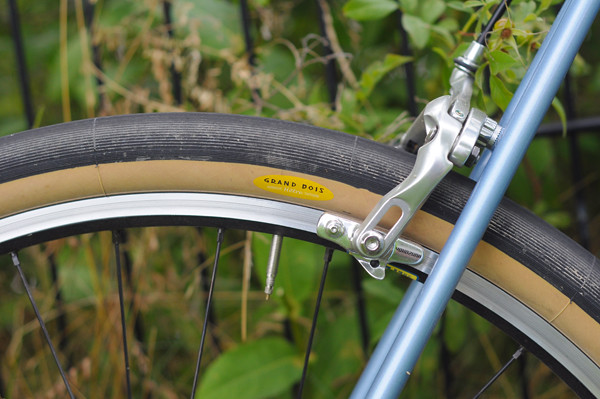
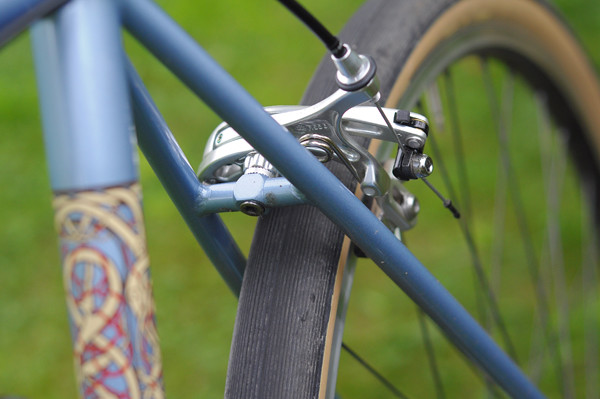

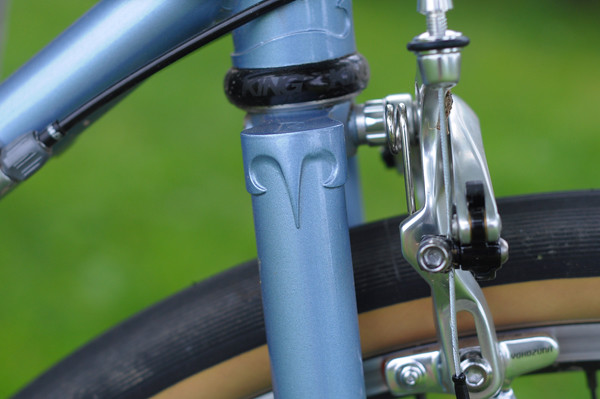
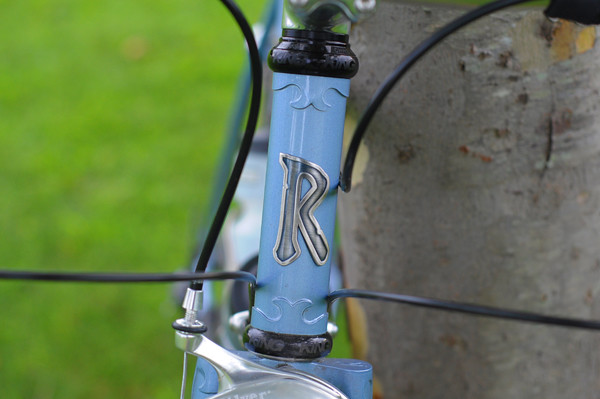
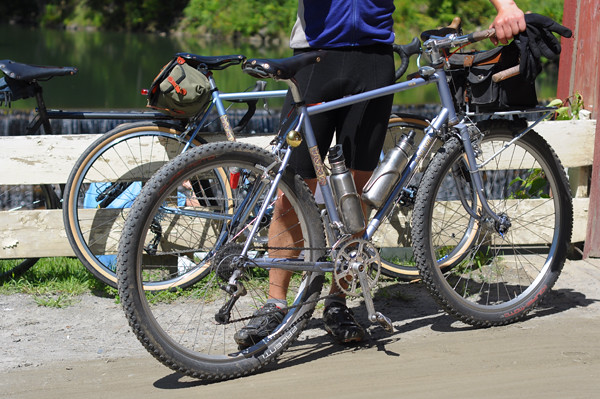
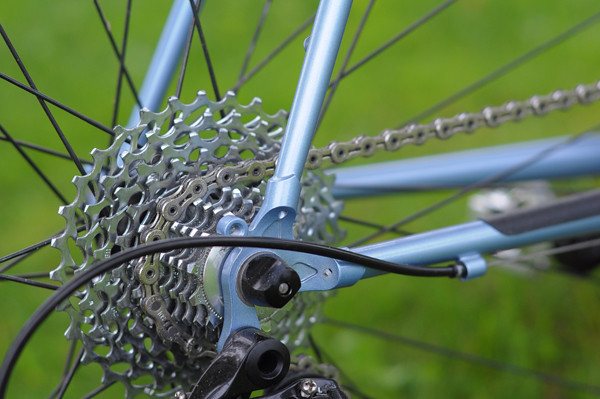
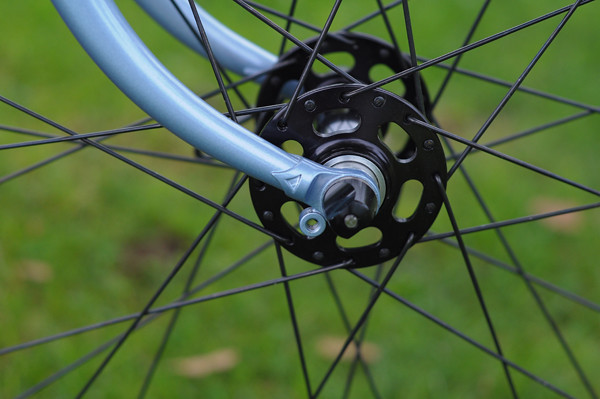
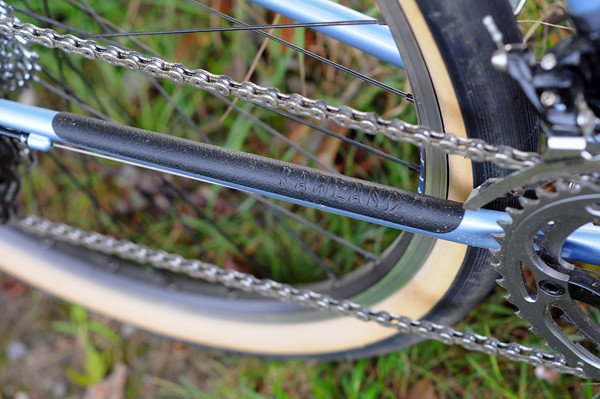
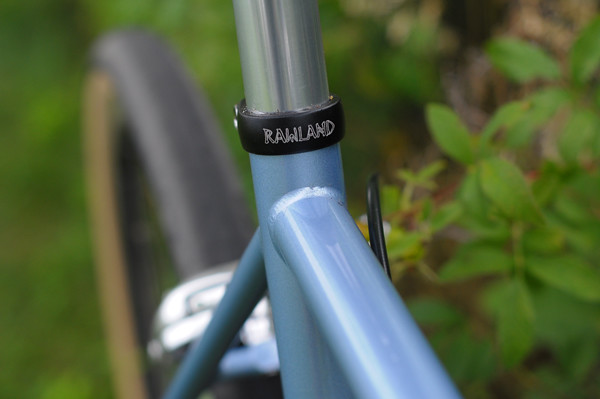

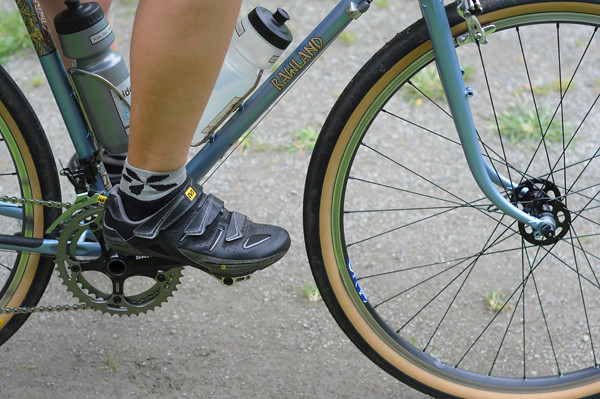
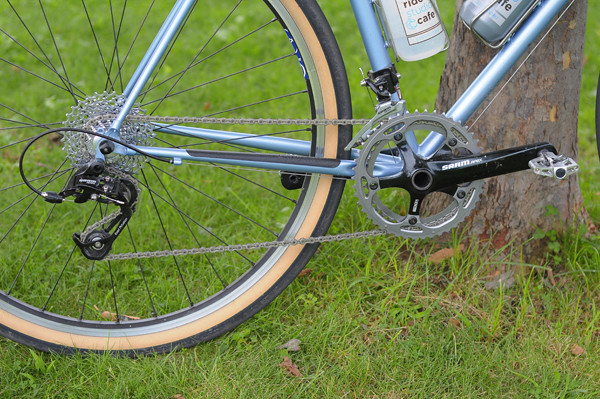


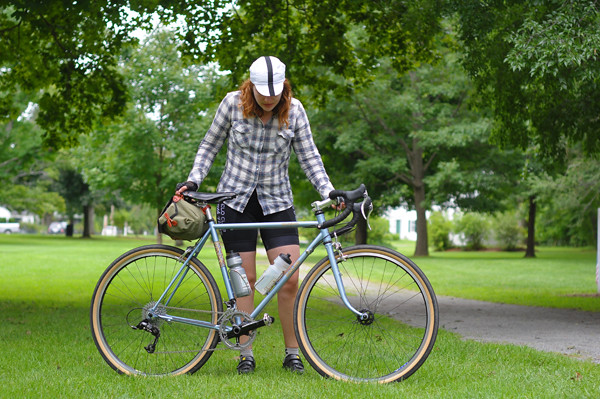
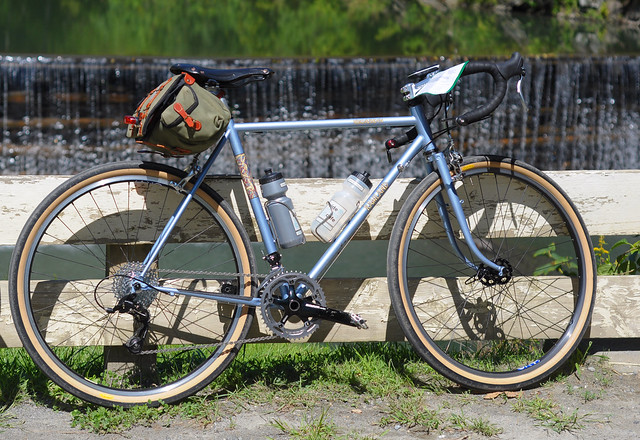
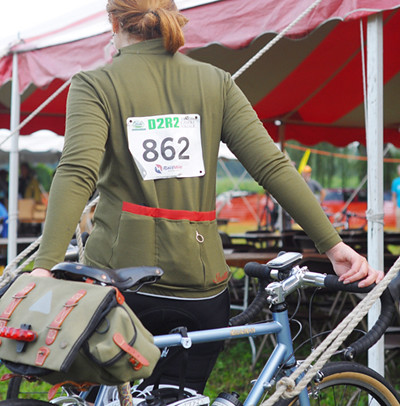
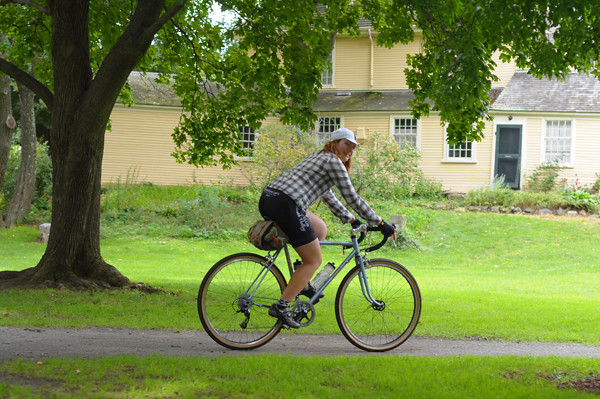
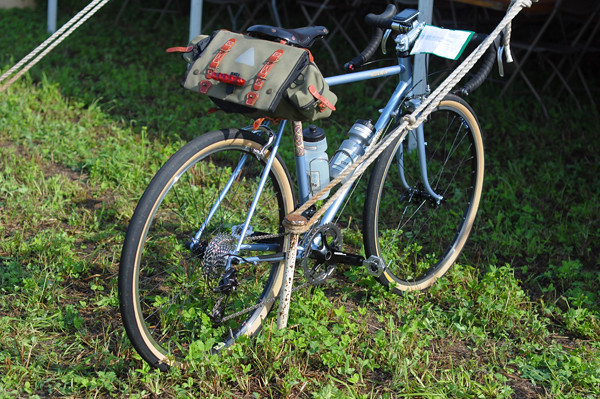
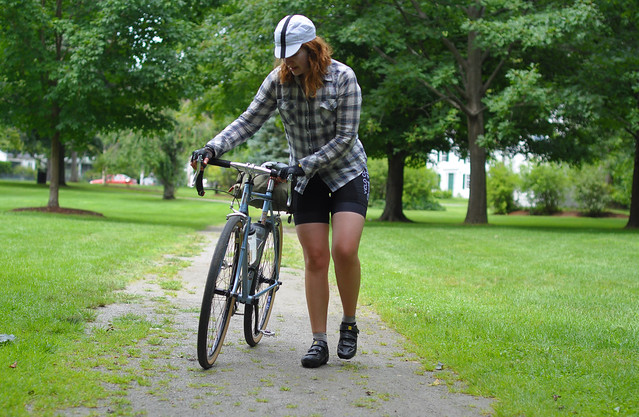
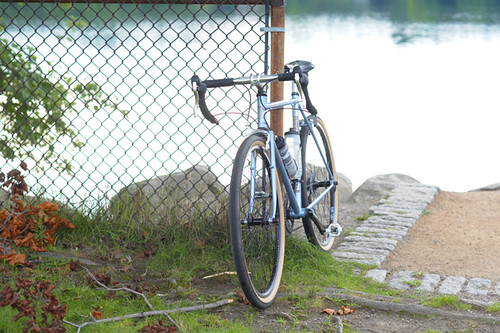
My question is why not a smaller size? I had looked at the Rawland's website and was dismayed that the small Nordavinden is 54cm, and that their other frames have been too large for short people as well. The Nordavinden does look nice. Did you enjoy being on hetres again?
ReplyDeleteHi Heather,
DeleteWhen I designed the Nordvinden as a 700c sportive for randonneuring, fast touring, and so on, I wanted to keep the front end geometry similar, if the same across all frame sizes. Otherwise two frame sizes with a different geometry would amount to two different models.
To that end, I decided to go with 650b for 54cm so that there would be no toe overlap, like all other sizes and Rawland models for that matter. That way the front geometry would remain intact, resulting in a similar experience across all frame sizes. I should note that the Hetre is cushier, so it has a slightly different gyroscopic effect compare to the 700x28 Grand Bois I currently ride.
I could go with a smaller frame size with a shorter top tube; however, the maximum tire size would be about 38c, resulting in a different front end geometry (i.e., lower trail).
Having ridden both 650b and 700c versions of the Nordavinden, I am quite proud of the outcome of all this. Fwiw, the upcoming Stag will be 650b for all frame sizes.
Sean
Heather - Yes, I really like Grand Bois Hetre tires. They'd be a must on any road-to-trail bike I have in the future.
DeleteFWIW I like that Rawland applied their design concepts as a 700c go-fast bike in the larger sizes. There aren't many/any 700c bikes like it, especially at such a reasonable price.
Delete24lb is not light enough for you? Don't take this as a criticism, I am just wondering what you think would be a reasonable weight.
ReplyDeleteTed
I think it is a very reasonable weight for a bike of its kind. And yet, I would not mind a lighter one. Keep in mind also that 24lb is what it weighs pared down. Add fenders, dynamo lighting, rack and handlebar bag, and the weight will start climbing. FWIW, here is an 18lb build... though with skinny tires.
DeleteActually I wonder how your test build managed to weigh so much. My Nordavinden 54 is still missing a front rack, but has VO fenders, a SON dynohub, centerpull brakes, and other decidedly non-racy parts, and it currently weighs 24.24 lbs with Hetres.
DeleteDon't know what to tell you, but the weight was confirmed by Rawland. Components can make a huge difference, so maybe there is something about the demo bike's vs your build.
DeleteAnon @ 4:09 - Yeah... gotta put a mini front rack with some sort of gravel grinder or rando bag on that baby of yours. Handling is significantly improved with a front load... it's like riding on rails! BTW, Velouria should have been made aware of that for review purposes. She didn't do herself any favors in the handling department by riding the Nordavinden around with a big saddlebag to carry her camera and other stuff. This might have further skewed (in a negative way) the handling of this bike.
DeleteI covered this in the review. While I am aware that the Rawland is optimised for a front load, I can only test ride a bike the way it is given to me. Sean at Rawland was confident the Nordavinden would handle fine with no front bag and even with a saddlebag - and it did. It is good to know that the bike is versatile and does not force the rider to set it up just so in order to get decent handling. Of course if it were my bike, front rack and small handlebar bag for sure.
DeleteAlso, it is worth noting that most of the time I rode it with no bag at all. I only attached the saddlebag for the D2R2.
It looks like a bike that fills a real need. If I were riding more trails, I'd consider it, or something like it.
ReplyDeleteHi Justine,
DeleteI agree. You would want to consider the upcoming Stag, Rawland's 5th anniversary 650b model. This one comes with cantilever bosses, and is optimized for 42mm or so. Like the Nordavinden, the top tube will be about 1.5 degrees. Here is a link to the Stag:
http://www.rawlandcycles.com/store/index.php?strWebAction=item_detail&intItemID=3968
Sean
I like it overall! I also think mid-20 lb. for weight is really reasonable for a gravel grinder bike. In regard to those wanting the ability to run 650b, Rawland's website shows a new frameset that will work with both wide tires 650b and 700c: The Drakkar II. If I were in the market for a new bike, I would personally wait for that one. The only thing missing there, however, is disc brake mounts. Disc brakes would make it a breeze to swap wheels of different sizes. I'm sure this is debatable, but I think disc brakes is also the way to go for gravel grinding purposes, especially in the rainy/muddy parts of the country.
ReplyDeleteA big plus about owning a Rawland bike is that in spite of having been around just a few years, they already seem to be quite sought-after or, at least, keep well their values. Apparently, their framesets are limited production only; each one with its distinctive characteristics and features. The fact that the Rawland's owner has won several design also helps a lot with keeping the resale value. Owning a bike that only a handful number of people have is quite an attractive point to me, even if it's made in Taiwan (prefer to support U.S. builders even at a premium.)
Velouria,
ReplyDeleteThe rims on the demo bike are 650b Velocity Synergy. Here is a link to the new Pacenti PL23 650b rim:
http://www.rawlandcycles.com/store/index.php?strWebAction=item_detail&intItemID=3967
Sean
Thanks/sorry, correction made!
DeleteNot a fan of discussions of weight when the bike is equipped with a heavy canvas bag, brooks saddle and a dslr.
ReplyDeleteAlso not a fan of lightness for lightness' sake when a little extra weight creates more stability on irregular terrain.
And lightness costs money.
Better to train and to minimize component/body weight.
Yes, we are nearly in the horrifying world of mountain biking.
We are also in the world of vintage road bikes that did everything. Looking at geo specs for the bigger sizes the Nordavinden is a clone of a '69 Bernard Carre I had last year for a while. Most of the bikes I've had over the years are not far off. Slightly less rake is usual but 74 or 73.5 head in the bigger sizes gives the same trail. And I prefer shallower seats, which the vintage often have. The "big" Pacenti fork crown is about the same as a bog standard Wagner or Davis.
DeleteAnybody interested in bikes that handle like the Rawland should check the old stuff. That Carre I could hardly get off my hands. It did not find a good home. The purchaser later told me he took the parts and dumpstered the frame.
There are far more of these bikes than will ever be ridden again.
Agree with Anon about the old stuff. Had a very nice '73 Motobecane Grand Record for a few years, built up as a fixed grocery getter and all rounder: fenders, dynamo, 30 mm tires, 67" gear. Despite the toute 531 legere frame, it handled 40 lb of groceries in the rear better than my current Rivendells and as well as the current Fargo. (Heh: I once cranked it up a 2/5 mile tres steep hill once at 4 mph/20 rpm with a total rear load including Packers of 45 lb.) Earlier, had a nice Fuji Royale UJB converted with 42 mm Avocets to a nice firm dirt road bike; oddly, this handled better with a rear load than unladen, and with a Boxy Bag in front was downright scary. The biggest challenge with old road steel is that, generally, the rear chainstays crowd anything bigger than about 37-40 mm.
DeleteYeah, the chainstays are the limiting factor. Even with 700x35 it's unlikely there will be real broken spoke clearance. And that's OK because if you could run 700x40 and used all the capability of a 700x40 the frame would not last so long.
DeleteGavia Pass at the '88 Giro had dirt as rough as D2R2. After that mad race powers that be decided to keep the wilder roads out of racing or confine them to Paris-Roubaix. In earlier years a bike had to have a lot of capability. LeMond took '83 World Champs with 2 broken spokes in the front wheel, standard bikes could do that then. Nighttime criteriums on cobbles in the rain were a normal part of racing life well into the 70s. Widest tires anyone in the postwar era would likely have used would've been Campionatos at about 29mm. Although I saw Jim Ochowicz win the '73 Old Town Criterium in rain and sand on Elvezias. How big were they? Maybe 30 or 32? Any frame would take them back then.
Jim,
ReplyDeleteI concur. The 22lb. Nordavinden prototype rode very well when I rode it extensively while underbiking around Mt. Diablo and the adjoining Morgan Territory a couple miles from here:
http://rawlandcycles.blogspot.com/2012/01/underbiking-nordavinden-at-morgan.html
With underbiking, there is no need to venture into the "horrifying world of mountain biking."
Sean
Sean, I was making a tongue in cheek comment regarding the author's previous distaste for mtb-ing; I personally love it and have ridden Diablo numerous times on one. MT...wasn't the road worse than the trails for awhile after all? <--truthful joke.
DeleteHetres being a must...ha wait until you hit some gnar. The Pacentis on John's Rawland look like just the ticket for anything that's a bit loose.
Hetres, but no gnar please! I have a sick feeling your definition of "a bit loose" is a little different from mine anyway.
DeleteI'd like to try a MTB with knobbies, why not. Actually, one of Rawland's older models looked nice.
Jon D switches between Hetres and the knobby Pacentis on his rSogn depending on the variety of unpaved riding he's doing. That bike is very versatile for someone like him.
I purchased a used Drakkar this spring (actuall found it right after reading the review of the rSogn. I had never heard of Rawland before) and love it! I have been switching between 42mm Hetres and Pacenti Neo Motos. I have done road/gravel rides with the Hetres.
DeleteThis summer while doing some pretty gnarly off-road touring on the Lost Coast in No. California I switched to the Neo's and they haven't come off since. I have even been exploring some single track and trail riding back in Portland, and have to say it is an absolute blast.
Cheers to such a fun and versatile bike!
I rode a friend's rSogn and found it surprisingly fast. This new bike is intriguing, but add me to those who wonder why all sizes are not 650B.
ReplyDeleteThanks for the compliment.
DeleteLike I mentioned above, the Nordavinden was initially designed as a 700c model; I later added 650b for size 54. The upcoming Stag is a 650b model, so you would want to check this out.
My lightweight 56cm Nordavinden with 28c tires rides and climbs much faster in comparison to the rSogn. Bear in mind there are some other variables in addition to wheel size and tire width, such as lighter tubing, a smaller crown and so on. It is for all those reasons I will always have a 700c Nordavinden in my stable.
Sean
The most loathesome 6 words anyone could read ona manufactured product: Designed in <1st world country> Made in <3rd world country>.
ReplyDeleteTaiwan is classified by the IMF as an advanced economy - same economic category as the US. Also see the discussion here.
DeleteI prefer it when a bicycle is designed and made by the same party, and even more so if it's local to me. But that drives up the price considerably.
I would love to have a bike designed and made locally, and along the way, my input taken into account. Cost would be high.
DeleteMany people have no idea what to think when Taiwan comes up.
it is more like Japan or Singapore, than China. It has not market itself well, but Velo Orange, when it visit the International bike trade show, in Taiwan, showed some local scenery.
Taipei is as modern and cosmopolitan as any city, (in fact, more so than Seattle where I am).
tadd
The more years I put into the bicycle Industry the more I think this attitude that can broadly be tipified as "made in china sucks!" is just racist.
DeleteThere are real reasons why manufacture in the native country is better than maufacture in the far east is. But these are rarely expressed. Its usual a short statement, like this, with no back up words.
The issue isn't quality. The far east are now so much more experienced with contemporary production techniques that the quality fo work outclasses many home gorwn buisnesses, and indeed much of the production done in the east would be impossible in a Western society that has moved in to a post maufacturing age.
The primary reason people have against far east production is psudo-ethical and imperial superiority. Factories and production bring people to cities. When people are in cities social change begins to happen, workers rights and human rights follow suite. This is how we arrived at the modern world in the west. The industrial revolution was the precurser to all the social revolutions we take for granted today. To my eyes this si the same process we are watching in the far east. Manufacture comes in and the social struggle for recognised democracy and equality begins and gains momentum.
Because they are different, and yes I mean they are a different colour and they speak a different language based on a different alphabet and have different gods to those of us from the west does not give you the right to pitty them, because to do so implies your superiority. And no offence, but whatever country you are from, don't go throwing stones in a glass house. Its got its own problems that other people is other countries look down on you for. So that false sense of superiority you have, born out of a latent racial prejudice; bury it. Its boring.
The real reasons to talk about local production are:
1) Freight costs and time scale
2) Time delay and laguage issues affecting communication
3) Owning your own process to prevent theft of design
4) Smaller scale production runs
5) Lower minimum orders
6) Faster/easier prototyping
7) Easier produict updating
8) easier and more accountable QC process.
But then most of these go out the window if you have your own factory in the far east (e.g. Giant as opposed to Velo Orange). Any reason why made locally products are superior to made in the far east that is based around morality, race, or superiority implie that you believe that you are a) better than those from the east by virtue of being western and b) that you denounce Global relationships in favour of blind patriotism at the expense of what it would really do to the people of your nation if your country moved back to "being an island" c) That ultimately you are scared of the future and deperately want to go back to the cold war-stand offf of the mid 20th century when life was a binary choice between good and evil and grey didn't exist.
So to you, the latent racist who hates modernity, I say get fucked.
I'm not either of the Anonymous posters above, but calling someone a racist because they dislike 'designed here, produced there' is uncalled for.
DeleteTHank you, Harry. I agree.
DeleteThere are good logical reasons that Japan revolutionized the bicycle industry and put the British motorcycle industry out of business. Then there's electronics, heavy equipment, automotive etc, etc etc. Yet not too long ago there was a popular nationalist/redneck notion in Western nations that anything made in japan was crap. Now it's Taiwan that is the target, at least in the bicycle industry. Taiwan is massively abundant in highly skilled tradespeople (eg welders that can weld anything on any given day from high end titanium products to low end aluminum bike frames). Add good engineering and low production costs and - boomba, a manufacturing powerhouse that the West can't compete with.
That being said, did anyone read that article from last Winter in Bicycling about Campagnolo perservereing despite the fact they've never sourced to Asia and that they continue to employ a union workforce? It's an interesting article (sorry no link, lazy bastard I am).
I think it's natural that people will be partial to, and proud of, things that are made in their own countries. Being Canadian I have a huge soft spot for Mariposa, Marinoni, vintage CCM Flyers (1930s CCM track bikes with Major Taylor stems... whoa! Pride and sorrow that CCM left bicycles behind for skates and now put their name on some of THE WORST bikes made). Swedes go nuts over Crescents, and on and on -- but to dis everything made in the far East is just plain ethnocentric.
-- Rolly
As I tried to explain in the post addressing this issue specifically, it's not about Taiwan vs China vs Japan vs Poland vs Italy - it's not about the location. Goods can be made well, and ethically in a developing country. Goods can be made poorly and unethically in a developed one.
DeleteSentimental attachment to a specific location because it's meaningful to us is totally understandable. Preferences for things to be made domestically/locally is as well. But if you are okay with outsourcing work in general, than to complain about a specific country of manufacture makes no sense, unless you have reason to believe that the conditions of the company's manufacturing process there are somehow inadequate. On their website, I think Rawland presents evidence to the contrary.
Cool. I missed the 'where your bike is made' post. Insightful and well put.
Delete--Rolly
How would you describe the difference in handling between this bike and the Rivendell SH? I do not want to rehash the whole speed and tubing discussion again, but I am interested in the handling.
ReplyDeleteFor someone not familiar with low trail handling, the best way I can describe it is that the Rawland gives the rider more control over the steering and makes tight turns very easily. To me this feels pleasantly nimble, but others describe it as disconcerting - as if "the bike feels hinged in the middle."
DeleteIn comparison, the Rivendell handled more like an unaggressive version of my Seven. What I guess would be called neutral steering and cornering.
Will the 54 cm still accommodate 42 mm with fenders?
ReplyDeleteYes
DeleteNice write-up. As my preferred and most easily available form of ride is dirt roads and pavement of varying quality thrown in, this will be a frameset I will covet. Just curious, what was the gearing on this bike? 11x34 in back, 44x34 up front or something like that? Thoughts?
ReplyDeleteI forgot what the big ring was, but the small was a 36t. The cassette was 12-32t. For me, this was just barely low enough for the "flat" D2R2 route. On my own bike of this kind I'd want a 1:1 gear.
Delete"My ideal frame size for a road fit would have a 53cm top tube, but the small Nordavinden worked nicely with a slightly shorter stem."
ReplyDeleteWhat size stem?
9cm stem on this bike, with a 54cm top tube;
Delete10cm stem on my road bike, with a 53cm top tube.
Compact handlebars on both.
Nice well balanced review as usual. I have been looking at Rawland Cycles for a few years now. While previous models have been overbuilt for my needs, Nordavinden may just be the one.
ReplyDeleteJust to make it clearer: Nordavinden is "the north wind" in Norwegian. "North wind" would be Nordavind. The difference is the two lwtters "en" in the end of the word. Same as "the" in front of a word in English.
ReplyDeleterSogn is not a word or name in Norwegian but Sogn is, like in the Sogn, Sognefjord or Sognefjorden name (pining for the fjords..).
Sogn is the actual name of the model and r stands for some aspect of the spec (the one with disk brakes was called dSogn).
DeleteI know about the "en" ending in Norwegian and Swedish. It's tricky in English with Norwegian-derived words.
what a masterpiece of an outfit! plaid shirt, bike shorts, flowery socks, clipless shoes ...and topped off with a rapha cap! love it :)))
ReplyDeleteI am a fashionista, what can I say. But it's a GB cycle cap : )
DeleteNot to make this all about your clothes, but I have a question about the D2R2 photo. Despite the large bag attached to the bike, it looks like you are also carrying things in your jersey pockets... why? Isn't it uncomfortable?
DeleteSteph P.
I find it very comfortable to carry things in a jersey's rear pockets. In a leaned-over roadbike position I cannot feel the weight at all, and it allows me to keep items within easy reach, without having to unfasten anything to get to them. I like to keep my phone, money, and a snack in my jersey pockets even when a bag is attached to the bike.
Delete"on steep climbs (with a full saddlebag, the front end "wandered" a bit"
ReplyDeleteJan Heine has said on several occasions that adding a light front bag to a low trail bike sometimes improves handling.
Me, just bought a '12 Novara Fusion for a friend and hope to do the minimal remaining conversions (massive anti-goathead measures for the tires, Axiom Dutch panniers, bar mirror) shortly and take it for a ride: am particularly interested in trying the Alfine 8 sp rear. It's a bike completely different from anything I've owned.
Low trail bikes are designed for a front load. Some assume this means they cannot be ridden without one, let alone with the weight exclusively in the rear. This bike however did fine even with the latter, which is worth noting.
DeleteSo, is it the pronounced fork curvature that makes it a "low trail" bike? Or does that just address toe overlap? Excuse the naive questions.
ReplyDeleteTrail is the distance from where the tire meets the pavement forward to where the headtube/fork would intersect the ground (if it went straight all the way to the ground). A more pronounced curve of the fork (rake) moves the tire further forward, moving it closer to the spot where the fork would hit the ground. Conversely, steepening the angle of the headtube/fork moves the imaginary spot backwards towards the tire.
DeleteThe effect "lightens" the steering, which means a bike with this geometry will handle well with a front load, whereas a bike with standard "trail" number would feel sluggish and difficult to control. Reduced toe-overlap is merely a pleasant side effect.
It looks like a 650B conversion. Should be possible to fit normal reach brake calipers and ride away on 700x35 wheels. It would mean a centimeter more standover and somewhat less toe clearance.
ReplyDeleteI think it looks well balanced. I find a bike (frame) this size often look silly with 622 wheels. Guess it is all about what you are used to look at. Nothing wrong with a 650B conversion by the way. Lots of great old roadbikes out there that can be made much more useful that way.
DeleteIt comes down to personal preference. I would rather ride 650Bx42 than 700Cx35 for sure, so I am very happy the small size comes in 650B.
DeleteCurious: why this preference? I've ridden various tire diameter/width combinations for years, including road bikes with 559 or 571 wheels and 1" tires and off road bikes with 622 wheels and fat tires, and conclude that, while there is noticeable difference in the way a 29", 2.5" tire handles washboard and sand compared to ditto on a 26" tire, on the road, not so much. I have never ridden 584/650B.
DeleteNote: just asking, not criticising.
It doesn't come in 650B so much as one frame has been built in 650B. Any of the larger sizes could just as well be built 650B. All will suffer from excess fork blade length, approximate clearances, and make-do brake calipers. Yes, 650 conversions often work extremely well. At least with this one the conversion has been tested and shown to be successful.
ReplyDeleteI'm wondering if the larger sizes could run 650B wheels by using longer-reach brakes (i.e., the ones spec'd on the test bike).
ReplyDeleteFor anyone reading - Rawland is having a Labor Day weekend sale on the Nordavinden frame sets, $100 off the usual price!
ReplyDeleteI don't know why you couldn't maintain the same front-end geo with a shorter top tube and keep the same clearances. Even if you couldn't, varying angles with frame size doesn't mean you're making different models. At least none of the other manufacturers who have ever done this feel that way. Anyhow, why not keep the 54cm top tube and shorten the seat tube? Or steepen the seat tube and shorten the top tube. Hardly anybody who rides a frame with a 52cm c-t-t seat tube will be able to ride a 73 degree seat tube without a zero setback post anyway. If the trail is the same, and the rider can balance their weight between the wheels in the same way, then changing the geometry would not effect the ride characteristics or ride quality, and shouldn't be considered a change in design.
ReplyDeleteI'm not sure what you mean when you say your seven is faster. Do you mean it has a higher top speed? Or do you mean it accelerates quicker?
ReplyDeleteYes and yes. Holding me as the rider constant, the 7 is generally a bit faster in every way (top, cruising, acceleration), except when riding on unpaved terrain. The difference in speed on paved roads is not dramatic, but it's there.
DeleteI suggest that can only be due to the tires, your physical condition on a particular day or your imagination.
ReplyDeleteWe may never know, Tony. Ultimately reviews are subjective and every reader can extract their own conclusion.
Deleteassume same tire size, same rider power, same position on bikes and use 0.001 slope to approximate a level road. assume your seven is say 1 or 1.5 kg lighter. plug in the numbers run the program and you sure wont get much of a time distance over 2000 meters. about 0.25 seconds!
Deletehttp://www.analyticcycling.com/ForcesLessWeight_Page.html
1. The Seven is actually 7lb (3.18kg) lighter.
Delete2. We can't assume the same tire size, considering the bikes are inherently built (and optimised) for different wheel and tire sizes.
3. A bicycle's performance is determined by more than weight and tire size alone.
Tony, this is not a debate where there can be a winner. This argument is a very old one. Respectfully, I bow out.
its not a debate, its the laws of physics. telling folks that one frame design has a higher top speed than another is simply wrong.
DeleteThat saddlebag looks really beatiful, where's it from?
ReplyDelete